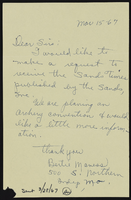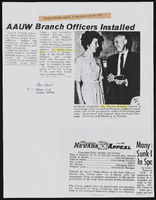Search the Special Collections and Archives Portal
Search Results

Transcript of interview with Jerome Countess and Dorothy Eisenberg by Barbara Tabach, October 28, 2014
Date
Archival Collection
Description
Interview with Jerry Countess and Dorothy Eisenberg by Barbara Tabach on October 28, 2014. Countess discusses his childhood and military life. He became involved in the United Jewish Appeal in Las Vegas and started the Jewish Reporter newspaper. Dorothy Eisenberg is also involved in the interview to discuss the Jewish Federation and the Jewish community.
Jerome Countess, known as Jerry to most, was born on December 22, 1920 in Brooklyn, New York. He grew up in the borough's Jewish neighborhood, and he developed a reputation for being a skillful handball player and a great dancer. Though he was not allowed to enlist in the U.S. Coast Guard due to colorblindness, Jerry was eventually drafted into the army during World War II. With very minimal combat training, Jerry was sent to North Africa as an infantryman, and was later stationed in Italy. After three years of service, Jerry returned home and married his childhood sweetheart, Rachel, in 1945. Using the G.I. Bill, he enrolled at New York University to study writing, though he quit just shy of graduation as his wife was expecting. After briefly working in the television broadcasting industry, Jerry landed a job with the United Jewish Appeal. In 1975, following in his desire to move west, Jerry took the job of executive director of the Combined Jewish Appeal in Las Vegas, what would soon be renamed the Jewish Federation of Las Vegas. Under his leadership, the federation started the Jewish Family Service as well as The Jewish Reporter, a monthly publication to promote engagement of the Jewish community. Jerry served as the executive director of the federation for many years, serving at the pleasure of many board members and presidents, including the first female federation president, Dorothy Eisenberg.
Text

Transcript of interview with Bob Campagna by Kathleen Neumann, March 17, 1978
Date
Archival Collection
Description
Text

Sands Times magazine subscription requests
Date
Archival Collection
Description
Series VIII. Sands Hotel Interior and Exterior
Text
Series II. Family Papers, 1845-1986
Level of Description
Scope and Contents
The Family Papers series contains family papers from 1845 to 1986 and consists of mining and stock certificates, receipts, newspaper clippings, and personal papers including report cards and diaries. It also includes fictional writing by Seymour Kimball Bradford. The series also includes papers belong to Nan Doughty documenting her personal and professional life, as well as her interest in her family history.
Archival Collection
Collection Name: Nan Doughty Family Collection
Box/Folder: N/A
Archival Component
Subseries 2.4 Las Vegas Diamond Jubilee (LVDJ), 1978-1981
Level of Description
Scope and Contents
The Las Vegas Diamond Jubilee sub-series (1978-1981) contains minutes, correspondence, events, newspaper clippings, press releases, and publications related to the celebration in honor of the 75th anniversary of the auction of lots by the San Pedro, Los Angeles and Salt Lake Railroad that led to the founding of the City of Las Vegas. John F. Cahlan served as director for the committee that organized celebrations for the Diamond Jubilee.
Archival Collection
Collection Name: Florence Lee Jones and John Cahlan Papers
Box/Folder: N/A
Archival Component
Personal papers, photographs, and designs, 1953-2005
Level of Description
Scope and Contents
The personal papers, photographs, and designs (1953-2005) contain Jerry Jackson's personal photographs and general professional papers and designs unrelated to a specific production. Professional papers include Jackson's resumes, magazine and newspapers articles about Jackson, and costume design drawings by Jerry Jackson and Nolan Miller. The costume designs were created for unidentified shows and were never used or fabricated for a particular production.
Archival Collection
Collection Name: Jerry Jackson Papers
Box/Folder: N/A
Archival Component
Show production materials, approximately 1950 to 2010
Level of Description
Scope and Contents
The Show production materials series (1950-2010) consists of documents, promotional materials including newspaper advertising, set and costume designs, and sheet music scores related to Bill Moore and George Arnold stage and ice shows in Las Vegas, Nevada and other locations. Also included are three-dimensional miniature set designs and other production-related objects such as fabric samples and datebooks.
Archival Collection
Collection Name: Bill Moore Professional Papers
Box/Folder: N/A
Archival Component
E. P. Carville Scrapbook
Identifier
Abstract
The E.P. Carville Scrapbook (1941) compiled by former Nevada Assemblyman H.E. Hazard documents Carville's governorship of Nevada. It contains articles from a number of Nevada newspapers on topics including the Rio Tinto mine strike, mining, gasoline and liquor taxes, Civil Defense activities, and other issues of importance in 1941.
Archival Collection


